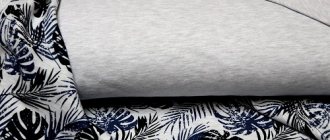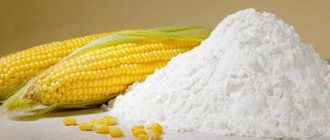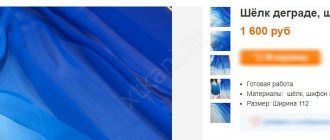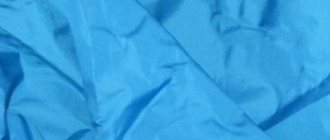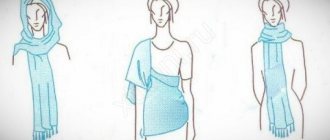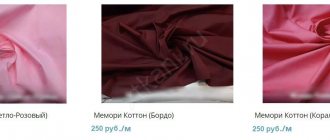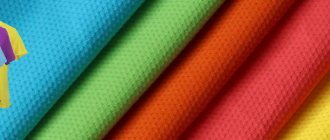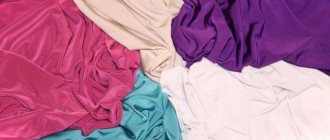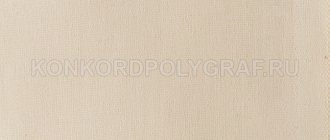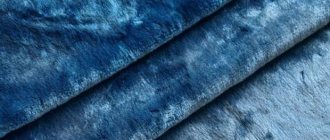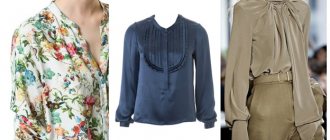Melange is a fabric made from fibers dyed in different colors. Translated from French, the word melange means a mixture of ingredients and fully corresponds to the type of textile in question. The threads present in melange yarn can have contrasting colors or barely differ in halftones, be natural or synthetic. Variegated fabrics are used for sewing outerwear, casual wear, and home textiles. From melange yarn, needlewomen knit fashionable and comfortable knitwear of stunning beauty.
What kind of material is this?
This type of fabric is made from single or twisted melange yarn. Finishing operations for cotton heather fabric consist mainly of trimming, napping and tying, but do not include bleaching, as this would destroy the color of the fibers. The same applies to wool melange fabrics.
Melange colors
Thus, to obtain a melange fabric, you can use single-strand yarn from multi-colored fibers or twisted yarn, consisting of threads of different colors. The resulting material does not require painting.
There are two main types of melange fabric:
- Blended - when different fibers are mixed in a certain fixed ratio (for example, polyester and cotton)
- Unblended – when differently dyed fibers of the same type are used (for example, 100% cotton)
Threads are mixed in two ways: contrasting (when a combination of fibers of completely different colors gives things a bright, festive look) and gradient - with a smooth transition of colors and calm undertones.
In Russia, melange yarn and fabrics are produced by dozens of textile industry enterprises, the largest of which are located in the traditional centers of the textile industry - in Moscow, Moscow, Ivanovo and Vladimir regions; the Barnaul melange plant is also well known.
Areas of application of the material
The melange color looks good in any clothes - a casual jumper, a smart coat or a tracksuit. The material is used to create:
- jackets and trousers from suits;
- coat, short coat;
- things for sports activities;
- furniture covers;
- bedspread
Skillful housewives knit amazingly beautiful things of any style from yarn. Hand-made bedspreads and rugs fit into the interior and complement it. Handmade lovers sew dolls, other toys or clothes for them from melange.
Composition and properties
Melange fabric can contain both natural (cotton, wool) and synthetic (nylon, nylon, lavsan) fibers, as well as their combinations. The use of synthetics makes it possible to create clothes with bright inclusions that cannot be achieved by working exclusively on natural raw materials.
Catalog of fabrics made from natural fibers
In addition to durability, as well as a spectacular and rich appearance, melange fabrics are cozy and pleasant to the touch - due to the bumps and roughness achieved by using different materials and threads in production.
Another amazing feature of the melange canvas is that, depending on the lighting, distance and viewing angle, it can look different.
Production
To create melange use:
- Yarn from a mix of multi-colored fibers;
- Single-color cotton yarn;
- Dyed gray yarn;
- Two-color gray yarn, twisted from two threads of different colors;
- Wool;
- Threads from chemically produced fibers (lavsan, nylon, nylon) - allow you to create fabrics with bright inclusions that are impossible when using only yarn from natural raw materials;
- Purified spinning waste (mainly for the production of dark-colored yarn, with increased linear density - for woolly melange).
For reference, gray yarn is made from cotton.
Read about: Tiara fabric: worthy appeal.
Primary color fibers (red, blue, yellow) are used to create secondary color fibers (orange, green or purple). A combination of two types of secondary color fibers, either primary and secondary, results in tertiary color fibers (brown, brown, olive).
textile melange
In melange production there is no common color numbering system. Each plant maintains its own recipe documentation, which reflects the results of dyeing individual types of fibers and yarns, blending combinations, dye formulas and associated process conditions.
Finished fabrics are not singed, bleached or dyed, so the quality of melange yarn is subject to increased quality requirements. In order to enhance the decorative appeal of the canvases, they can be subjected to brushing, cleaning, cutting, and mercerization. Thermal influence and finishing (treatment with mixtures based on glue, starch or resins, etc.) leads to an improvement in the wrinkle resistance of fabrics, wear resistance, etc.
Types of fabric
There are many of them, here are the most famous:
- Leotard is a dense multi-colored fabric that can be regular or costume.
- Covercoat is a thick woolen, half-woolen or cotton fabric made of twisted multi-colored threads (usually brown and yellow-brown) with a characteristic ribbed pattern, from which suits and coats are sewn.
- Cheviot is also a thin fabric made from half-wool or pure wool yarn.
- Diagonal is a fabric with a characteristic diagonal rib, often used for sewing military uniforms.
- Cloth is a long-known fabric, characterized by its special density and excellent thermal insulation properties.
- Drape is a two-layer woolen fabric of complex weave, in which the gaps between the interwoven fibers are eliminated by rolling.
- Boucle is a fabric woven from threads of different thicknesses and looks and feels like astrakhan, which is achieved by the presence of large knots on the yarn.
- Scandinavian matting is a durable and stylish fabric, 100% polyester.
Drape
What is drape? What are its properties and features?
more details
Cloth
Features of cloth, its properties and basic rules for caring for fabric
more details
Boucle
What are the properties and characteristics of bouclé fabric? Rules for caring for things made of material
more details
How to care for wool melange products
- wash in soft warm water using neutral powder
- iron from the inside out without heating the iron
- store suits and trousers in hanging condition
- It is better not to wash jackets and suits yourself, but to take them to dry cleaning
- dry in places protected from direct sunlight.
The properties of melange fabrics are good proof that combining materials with different characteristics brings good results.
© 2021 textiletrend.ru
Pros and cons of melange
Advantages:
- Always original appearance.
- Strength.
- Wearability, ability to retain shape for a long time.
- Resistance to mechanical stress.
- Huge selection of colors and shades.
Flaws:
- The difficulty of caring for products is due to the use of fibers of different composition.
- Fabric shrinkage - if it is made from natural fibers.
- Afraid of moths - if it contains wool.
- Stretches - if the base is knitwear.
- Deteriorates from high temperatures.
What color is beige melange?
In English, the word nude means both naked body and the color beige. Therefore, it includes all tones that are close to skin color. There are about 1000 shades of beige in the world.
A heterogeneous beige fabric that combines different tones of beige is also called melange. There is a huge group of beige tones, each of which is combined with certain colors. For example, gray-beige harmonizes with fuchsia, amethyst, ruby, emerald, brown, silver, azure.
Light beige melange - what color is it? It is visually similar to milky, belongs to the classics along with black and white, and can be combined with almost all colors.
Pinkish beige, sometimes called powdery, is warmer, and most importantly - versatile. It is suitable for both the office and a romantic date. It will look most advantageous with lilac, brown, gold and silver.
Compliance with government standards
GOST 29298-2005 applies to finished fabrics, including melange fabrics, which must not only comply with approved standard samples, but also meet the requirements of state standards for such indicators as:
- Color fastness of finished fabrics.
- Resistant to abrasion and breaking load.
- Compliance with physical and hygienic standards (air permeability, hygroscopicity, specific surface electrical resistance, formaldehyde content).
- Compliance with linear dimensions and surface density.
In addition, according to GOST, yarn, as well as all auxiliary finishing substances and dyes used in the production of fabrics, must strictly comply with the requirements of the Ministry of Health, also set out in the regulatory document.
Differences in composition
Melange threads vary in their composition. They are:
- cotton;
- woolen;
- mohair;
- acrylic.
Cotton is hygienic, washable, absorbs moisture well and allows air to pass through. Finished products made from such yarn are very comfortable and pleasant to wear.
Mohair melange yarn is very warm and durable, airy and soft. Its disadvantages include rolling and prickliness.
Wool yarn can retain heat well and is hygroscopic. Great for knitting textured and smooth patterns.
Acrylic can be described as a durable, thermoplastic, light-resistant material. This yarn dyes well, making the threads bright and shiny. Acrylic yarn can be used for hand or machine knitting.
How are these colors obtained?
Melange production technology does not provide for a single color designation.
Each factory has its own documentation to record the recipe and results of yarn dyeing. The composition and type of fibers, the mixture combination, and the formula for preparing the dye are also recorded. The finished melange fabric does not undergo bleaching, singeing or dyeing. Cleaning, cutting, napping, and mercerizing help to add decorative appeal, and treatment with adhesives increases strength and wear resistance.
The main directions in coloring are:
- Contrasting for obtaining variegated, rich canvases of mixed colors.
- Gradient, when threads of different colors of the same color are taken. The dark shade flows into the light one. For example, black to gray, brown to sand, and purple to lilac.
Secrets of mixing colors
Melange bag
Choosing the color of the threads involved in creating melange is a very difficult task. Each textile enterprise has its own color coding, mixture combinations, dye formulas, developed as a result of many years of work and usually kept secret. But basically, manufacturers adhere to two directions in combining colors.
- Contrasting. In this case, fibers of pure primary tones, for example, red, yellow, blue, are combined into a thread, resulting in a variegated fabric that visually has a mixed color (green, purple, olive, brown).
- Gradient. With this combination, to create melange fabric, fibers of the same color are chosen, but different in tone, for example, black and light gray, brown and beige. Visually, a darker color is softened by a light shade.
The most colorful and expressive fabrics are made from synthetic threads, as they are easily dyed in bright, saturated colors. Melange made from natural fibers, on the contrary, has a restrained monochrome color.
The yarn used to create multi-color fabrics must be of the highest quality, since the finished fabric is no longer subject to any additional processing. The only thing the manufacturer can afford is superficial cutting or mercerization, which will improve the wear resistance and wrinkle resistance of the material.
How to make melange at home
- Time: 10 minutes.
- Number of servings: 2 persons.
- Calorie content of the dish: 157 kcal. per 100 g.
- Purpose: preparation.
- Cuisine: multinational.
- Difficulty: easy.
This preparation greatly simplifies the preparation of dishes. In addition, it will always help out if you don’t have eggs on hand, but they are included in the recipe. Preparing melange does not take much time - 5-10 minutes is enough. The main rule is to use only high-quality fresh eggs. If it is necessary to prepare a dry mixture, then instead of the freezing stage, the eggs are poured into a plastic tray and placed in a place with incoming warm air. The product is dried for 20-24 hours. It is then separated from the pan and ground into powder.
- Home treatment for complex, myopic and mixed eye astigmatism
- How to treat warts on fingers
- Effective drugs for high blood pressure
Ingredients:
- eggs – 3 pcs.;
- salt - to taste.
Cooking method:
- Break the eggs into a bowl and beat them until foamy using a mixer.
- Add salt and mix.
- Place in a mold or bag and place in the freezer.
